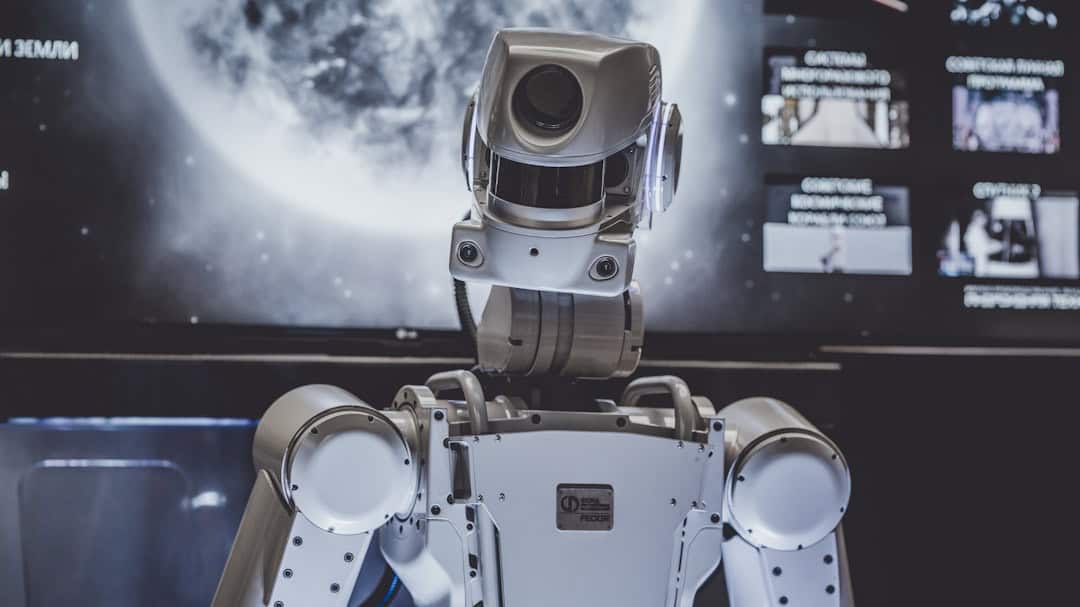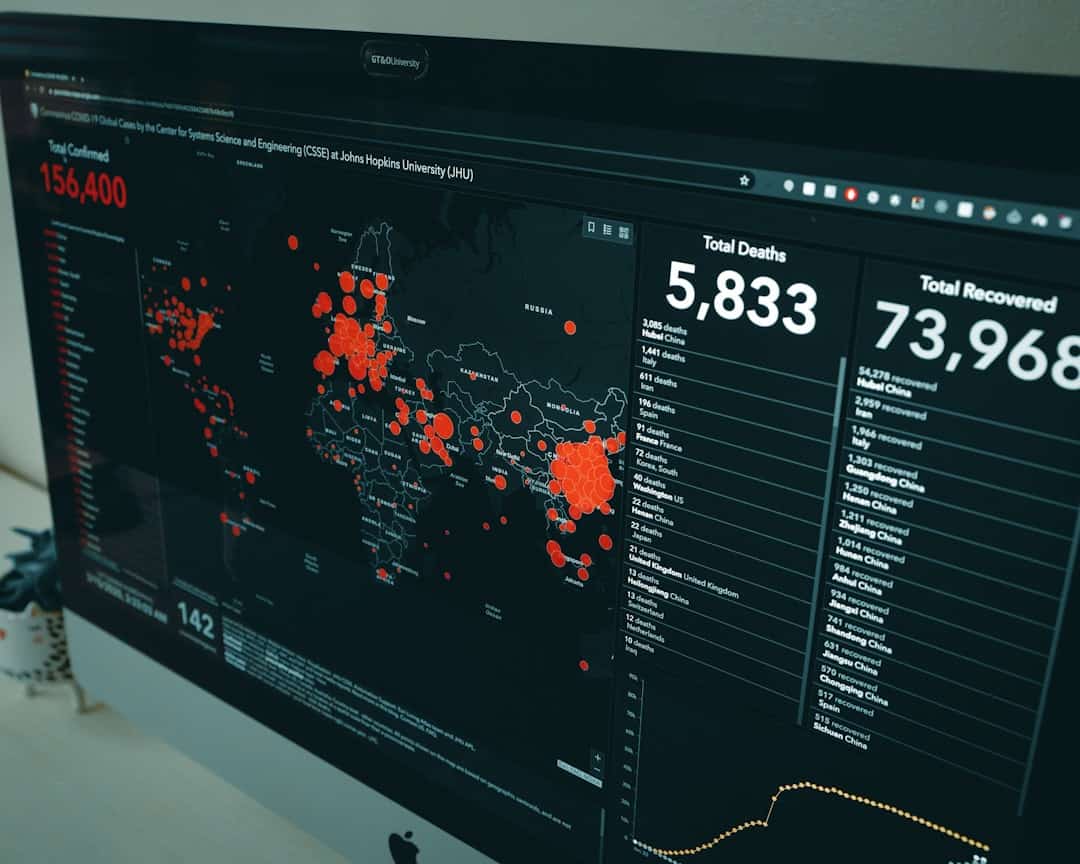Through the provision of creative solutions to enhance patient care, diagnosis, treatment, and medication development, artificial intelligence (AI) has completely transformed the healthcare sector. artificial intelligence (AI) is the mathematical modeling of human cognitive functions such as learning, reasoning, and self-correction by computers. AI has the ability to evaluate complicated medical data, spot trends, & forecast outcomes to help medical professionals make decisions that are more precise & timely. AI in healthcare has the potential to improve patient outcomes, lower medical errors, and maximize resource use. AI is anticipated to be a key factor in determining how healthcare is delivered in the future as the sector continues to embrace digital transformation.
Key Takeaways
- AI is revolutionizing healthcare by improving diagnostics, treatment plans, drug discovery, patient monitoring, and predictive analytics.
- AI applications in diagnostics and imaging are enhancing accuracy and efficiency in identifying diseases and abnormalities.
- Personalized medicine and treatment plans are being optimized through AI algorithms that analyze individual patient data and genetic information.
- AI is accelerating drug discovery and development by analyzing large datasets and predicting drug interactions and outcomes.
- Patient monitoring and predictive analytics are being improved through AI, allowing for early detection and intervention in healthcare.
Large volumes of medical data, such as patient records, imaging studies, genetic data, & clinical trial results, can be processed & analyzed by AI. Artificial intelligence (AI) is able to recognize subtle patterns and correlations that human clinicians might not immediately notice by utilizing machine learning algorithms. This may result in earlier illness detection, more precise diagnosis, and individualized treatment regimens catered to the requirements of each patient.
AI can also help with drug development and discovery by forecasting the safety and effectiveness of possible therapeutic candidates, which will eventually speed up the process of introducing novel treatments to the market. To preserve patient confidence & data security, however, the use of AI in healthcare also brings up ethical & privacy issues that must be properly addressed. Notwithstanding these difficulties, AI in healthcare has enormous potential to change the industry and enhance patient outcomes. Reading Medical Images Correctly. By making it possible to interpret medical images like X-rays, MRIs, and CT scans more accurately and quickly, artificial intelligence (AI) has significantly improved diagnostics & medical imaging. AI can analyze medical images to identify anomalies, categorize diseases, and help radiologists diagnose patients more accurately by using deep learning algorithms.
AI-powered image analysis, for instance, can assist in locating early indicators of neurological conditions, cardiovascular diseases, and cancer, enabling earlier intervention & better patient outcomes. Simplifying the Interpretation Procedure. AI can also expedite the interpretation process by assigning critical cases a higher priority for quick review, relieving radiologists of more work, and increasing workflow efficiency.
| AI Application | Impact |
|---|---|
| Medical Imaging Analysis | Improved accuracy in diagnosing diseases |
| Predictive Analytics | Early detection of potential health issues |
| Drug Discovery | Accelerated development of new medications |
| Virtual Health Assistants | Enhanced patient engagement and support |
Also, by combining data from various sources, such as genetic information, medical images, and patient histories, AI has the potential to improve diagnostic accuracy. AI can offer a more thorough understanding of a patient’s condition and assist clinicians in making better decisions by analyzing these varied datasets. Forecasting the Course of the Disease and the Reaction to Treatment.
AI’s ability to analyze longitudinal imaging data over time can also help predict how a disease will progress and how a treatment will work. Through the use of personalized treatment plans and earlier detection, these capabilities hold the potential to completely transform diagnostic procedures and enhance patient care. The application of AI in imaging and diagnostics, however, also brings up issues with algorithmic bias & the necessity of rigorously validating AI models to guarantee their dependability and safety in clinical settings. Using a patient’s genetic composition, lifestyle, and surroundings as a starting point, personalized medicine seeks to customize medical care.
Personalized medicine is greatly advanced by artificial intelligence (AI), which analyzes large, complex datasets to find biomarkers, forecast treatment outcomes, and tailor therapeutic approaches to individual patients. AI is capable of identifying patterns in massive genomic data to pinpoint genetic variants linked to medication metabolism & disease susceptibility by utilizing machine learning algorithms. Based on a person’s genetic profile, this information can be used to optimize drug regimens and guide treatment decisions. AI is also capable of analyzing a wide range of patient data, such as imaging studies, electronic health records, and real-time physiological measurements, to generate individualized treatment plans that take into account the particular traits and medical background of each patient.
By minimizing side effects, maximizing drug dosages, and decreasing the chance of treatment resistance, this strategy may enhance treatment outcomes. AI can also help predict how a disease will progress and identify patients who are more likely to experience complications, allowing for proactive interventions to avoid unfavorable outcomes. To ensure the safe and moral use of patient data for individualized treatment plans, strong regulatory frameworks are necessary, as well as concerns about data privacy and informed consent that are brought up by the application of AI in personalized medicine. Drug development & discovery is an expensive, time-consuming, and complex process. By evaluating massive amounts of biological data, forecasting drug-target interactions, and finding new therapeutic candidates, artificial intelligence (AI) has proven to be a potent instrument for quickening this process.
AI can identify possible drug targets & forecast the effectiveness of treatment candidates by utilizing machine learning algorithms to analyze a variety of datasets, including genetic data, protein structures, and chemical properties. By giving priority to compounds that show promise for additional preclinical and clinical testing, this strategy may expedite the drug discovery process. Also, by examining the molecular profiles of current medications & spotting any potential off-target effects, AI can help repurpose them for new uses. By utilizing current understanding of drug safety & pharmacokinetics, this strategy may hasten the development of novel treatments for illnesses that currently exist. AI can also predict treatment outcomes based on individual patient characteristics and identify patient subpopulations that are likely to benefit from a particular treatment, which can optimize the design of clinical trials.
Concerns concerning the need for stringent AI model validation, decision-making processes’ transparency, and ethical issues surrounding the use of patient data for predictive modeling are also raised by the integration of AI in drug discovery and development. By evaluating physiological data in real-time to identify early indicators of deterioration, forecast unfavorable events, & improve care delivery, artificial intelligence (AI) has the potential to revolutionize patient monitoring and predictive analytics. AI can analyze continuous streams of patient data from wearables, electronic health records, and remote monitoring systems by utilizing machine learning algorithms. This allows AI to find patterns that may indicate a decline in clinical care. Proactive interventions to avert unfavorable outcomes and lower hospital readmission rates could be made possible by this strategy.
AI can also help predict how a disease will progress by examining patient data longitudinally over time to spot patterns that could indicate a decline in health or a response to treatment. Care plans can be optimized using this information by tailoring them to the specific needs of each patient. Also, by anticipating patient flow within healthcare facilities, identifying care delivery bottlenecks, and more effectively allocating resources, AI can help optimize resource utilization. But the use of AI in predictive analytics & patient monitoring also brings up issues with algorithmic bias, data security, and the requirement for thorough model validation before using AI in clinical settings. Patient confidentiality and data protection.
Ensuring the privacy and security of patient data is crucial because AI systems need to be trained and validated on large volumes of data. Upholding patient trust & adhering to regulatory requirements necessitates this. Fairness & Algorithmic Prejudice. Concerns concerning algorithmic bias and fairness in treatment recommendations are raised by the use of AI in healthcare decision-making. To guarantee that all patients receive fair treatment, it is crucial to thoroughly assess AI models for any potential racial, gender, or socioeconomic biases. Openness and Knowledgeable Consent.
For physicians to be able to comprehend how AI recommendations are created & make well-informed decisions regarding patient care, transparent decision-making procedures are required. In addition, protecting patient autonomy and privacy rights requires getting informed consent before using patient data in AI systems. By boosting diagnostic accuracy, enabling tailored treatment plans, speeding up drug discovery, streamlining care delivery, and enhancing patient outcomes, artificial intelligence (AI) in healthcare has enormous potential to improve healthcare delivery in the future. Nonetheless, in order to fully utilize AI in healthcare, a number of obstacles must be overcome.
The difficulties lie in guaranteeing data security and privacy, dealing with issues of algorithmic bias and fairness, creating strong legal frameworks for AI-powered medical devices & software, successfully incorporating AI into clinical workflows, & attending to workforce training requirements for AI adoption in healthcare settings. In addition, patient safety, ethical issues, and decision-making openness must be given top priority as healthcare organizations embrace digital transformation by incorporating AI technologies into clinical practice. The healthcare sector can fully utilize AI to enhance patient care delivery while maintaining moral principles and fostering patient confidence in AI-enabled healthcare solutions by proactively tackling these issues. In conclusion, AI has the power to completely transform healthcare through the improvement of patient outcomes, accelerated drug discovery, personalized treatment plans, optimized care delivery, and enhanced diagnostic accuracy.
In order to successfully integrate AI into clinical workflows and address workforce training needs for AI adoption in healthcare settings, a number of challenges must be addressed. These include ensuring data privacy security, addressing algorithmic bias fairness concerns, and prioritizing patient safety, ethics, and transparency in decision-making processes. The healthcare sector may fully utilize AI to enhance patient care delivery while maintaining ethical standards and building patient confidence in AI-enabled healthcare solutions by proactively tackling these issues.
If you’re interested in learning more about the potential impact of AI on virtual economies and digital assets within the metaverse, you should check out this insightful article on metaverse platforms and ecosystems. It delves into how AI applications could revolutionize the way we interact and transact within virtual worlds.
FAQs
What is AI application?
AI application refers to the use of artificial intelligence technology to perform specific tasks or functions that would typically require human intelligence. This can include tasks such as speech recognition, decision-making, problem-solving, and more.
What are some common examples of AI applications?
Some common examples of AI applications include virtual personal assistants (such as Siri or Alexa), recommendation systems (such as those used by streaming services or e-commerce platforms), autonomous vehicles, and predictive analytics.
How is AI application used in business?
AI application is used in business to automate repetitive tasks, improve decision-making processes, enhance customer experiences, and optimize operations. This can include using AI for data analysis, customer service chatbots, and predictive maintenance in manufacturing.
What are the benefits of AI application?
The benefits of AI application include increased efficiency and productivity, improved accuracy and consistency, enhanced customer experiences, and the ability to handle large volumes of data and complex tasks.
What are the potential risks or challenges of AI application?
Some potential risks or challenges of AI application include job displacement, ethical considerations (such as bias in algorithms), privacy concerns, and the potential for misuse of AI technology. It is important to carefully consider these factors when implementing AI applications.











Leave a Reply